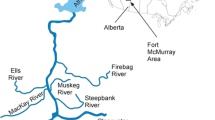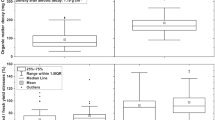Abstract
Experiments were conducted in an annular flume using waste bed sediment from a discontinued aquaculture operation to assess its stability against erosion. Critical shear stress for erosion was measured under different flow conditions and after three different consolidation periods (2, 7 and 14 days). The influence of biostabilization was also assessed as a mechanism for controlling the bed sediment stability. Results suggest a moderate increase in bed sediment strength with time as evidenced by the increasing critical bed shear stress for erosion with increasing consolidation times. Critical bed shear stress for erosion ranged from 0.06 to 0.1 Pa. Eroded floc size and settling velocities were in the range that would allow for significant horizontal transport of sediments provided a flow was present (i.e. transport outside of the aquaculture pens). The increase in sediment strength with time is believed to be more strongly influenced by biofilm integration on and within the surface sediment layer than to consolidation and dewatering effects. Extensive biofilm growth was visibly evident and microscopy confirmed the presence of extensive filamentous organisms (likely of a fungal origin) and bacteria. The point of failure of this biostabilized sediment was significantly lower than that reported for other natural freshwater and salt water sediments. Regardless of the sediment type, however, biostabilization is a consistent and important mechanism which controls the stability of sediments. Factors such as the microbial community and sediment floc structure will need to be considered in order to improve our understanding of the mechanisms of bed sediment stability and erosion for the environmentally sustainable operations of aquaculture facilities.





Similar content being viewed by others
References
Amos, C. L., Droppo, I. G., Gomez, E. A., & Murphy, T. (2003). The stability of a remediated bed in Hamilton Harbour, Lake Ontario, Canada. Sedimentology, 50(1), 149–165.
Amos, C. L., Bergamasco, A., Umgiesser, G., Cappucci, S., Cloutier, D., DeNat, L., et al. (2004). The stability of tidal flats in Venice Lagoon – The results of in-situ measurements using two benthic, annular flumes. Journal of Marine Systems, 51, 211–241.
Austen, I., Andersen, T. J., & Edelvang, K. (1999). The influence of benthic diatoms and invertegrates on the erodibility of an intertidal mudflat, the Danish Wadden Sea. Estuarine, Coastal and Shelf Science, 49, 99–111.
Beltaos, S., & Rajaratnam, N. (1973). Plane turbulent impinging jets. Journal of Hydraulic Research, IAHR, 11(1), 29–59.
Black, K. S., Tolhurst, T. J., Paterson, D. M., & Hagerthey, S. E. (2002). Working with natural cohesive sediments. Journal of Hydraulic Engineering, 128, 2–8.
Bura, R., Cheung, M., Liao, B., Finlayson, J., Lee, B. C., Droppo, I. G., et al. (1998). Composition of extracellular polymeric substances in the activated sludge floc matrix. Water Science and Technology, 37(4–5), 325–333.
Chen, Y-S., Beveridge, M. C. M., & Telfer, T. C. (1999). Settling rate characteristics and nutrient contnent of the faeces of Atlantic salmon, Salmo salar L., and the implications for modelling of solid waste dispersion. Aquaculture Research, 30, 395–398.
Cromey, C. J., Thomas, T. D., & Black, K. D. (2002). DEPOMOD – Modeling the deposition and biological effects of waste solids from marine cage farms. Aquaculture, 214, 211–239.
Defarge, C., Trichet, J., Jaunet, A.-M., Robert, M., Tribble, J., & Sansome, F. J. (1996). Texture of microbial sediments revealed by cryo-scanning electron microscopy. Journal of Sedimentary Research, 66, 935–947.
Droppo, I. G. (2001). Rethinking what constitutes suspended sediment. Hydrological Processes, 15(9), 1551–1564.
Droppo, I. G. (2004). Structural controls on floc strength and transport. Canadian Journal of Civil Engineering, 31, 569–578.
Droppo, I. G., & Amos, C. L. (2001). The structure, stability and transformation of contaminated lacustrine surface fine-grain laminae. Journal of Sedimentary Research, 71(5), 718–727.
Droppo, I. G., Flannigan, D. T., Leppard, G. G., Jaskot, C., & Liss, S. N. (1996). Floc stabilization for multiple microscopic techniques. Applied and Environmental Microbiology, 62(9), 3508–3515.
Droppo, I. G., Lau, Y. L., & Mitchell, C. (2001). The effect of depositional history on contaminated bed sediment stability. Science of the Total Environment, 266(1–3), 7–13.
Droppo, I. G., Leppard, G. G., Flannigan, D. T., & Liss, S. N. (1997). The freshwater floc: A functional relationship of water and organic and inorganic floc constituents affecting suspended sediment properties. Water, Air and Soil Pollution, 99, 43–53.
Droppo, I. G., & Stone, M. (1994). In-channel surficial fine-grained sediment laminae (Part I): Physical characteristics and formational processes. Hydrological Processes, 8(2), 101–111.
Focardi, S., Corsi, I., & Franchi, E. (2005). Safety issues and sustainability development of European aquaculture: New tools for environmentally sound aquaculture. Aquaculture International, 13, 3–17.
Friend, P. L., Ciavola, P., Cappucci, S., & Santos, R. (2003a). Bio-dependent bed parameters as a proxy tool for sediment stability in mixed habitat intertidal areas. Continental Shelf Research, 23, 1899–1917.
Friend, P. L., Collins, M. B., & Holligan, P. M. (2003b). Day-night variation of intertidal flat sediment properties in relation to sediment stability. Estuarine, Coastal and Shelf Science, 58, 663–675.
Gowen, R. J., & Bradbury, N. B. (1987). The ecological impact of salmonid farming in coastal waters: A review. Oceanography and Marine Biology Annual Review, 25, 563–575.
Gowen, R. J., Smyth, D., & Silvert, W. (1994). Modelling the spatial distribution and loading of organic fish farm waste to the seabed. In B. T. Hargrave (Ed.), Modelling benthic impacts of organic enrichment from marine aquaculture. Canadian technical report – fisheries and aquatquatic science, 1949, 19–30.
Hargrave, B. T., Duplisea, D. E., Pfeiffer, E., & Wildish, D. J. (1993). Seasonal-changes in benthic fluxes of dissolved-oxygen and ammonium associated with marine cultured Atlantic salmon. Marine Ecology-Progress Series, 96, 249–257.
Hawley, N. (1982). Settling velocity distribution of natural aggregates. Journal of Geophysical Research, 87(C12), 9489–9498.
Henderson, A. R., & Ross, D. J. (1995). Use of macrobenthic infaunal communities in the monitoring and control of the impact of marine cage fish farming. Aquaculture Research, 26, 659–678.
Hevia, M., Rosenthal, H., & Gowen, R. J. (1996). Modelling benthic deposition under fish cages. Journal of Applied Ichthyology, 12, 71–74.
Karthikeyan, S., Wolfaardt, G. M., Korber, D. R., & Caldwell, D. E. (1999). Functional and structural responses of a degradative microbial community to substrates with varying degrees of complexity in chemical structure. Microbial Ecology, 38, 215–224.
Krumbein, W. E., Paterson, D. M., & Stal, L. J. (Eds.) (1994). Biostabilization of Sediments. Oldenburg, Germany: Verlag.
Lau, Y. L. (1993). Temperature effect on settling velocity and deposition of cohesive sediments. Journal of Hydraulic Research, 32, 41–51.
Li D.-H., & Ganczarczyk J. (1987). Stroboscopic determination of settling velocity, size and porosity of activated sludge flocs. Water Research, 21, 257–262.
Liss, S. N., Droppo, I. G., Flannigan, D., & Leppard, G. G. (1996). Floc architecture in wastewater and natural riverine systems. Environmental Science and Technology, 30, 680–686.
Mazur, N. A., & Curtis, A. L. (2006). Risk perceptions, aquaculture, and issues of trust: Lessons from Australia. Society and Natural Resources, 19(9), 791–8080.
Mehta, A. J. (1989). On estuarine cohesive sediment suspension behaviour. Journal of Geophysical Research, 94(C10), 14303–14314.
Neumeier, U., Friend, P. L., Gangelhof, U., Lunding, J., Lundkvist, M., Bergamasco, A., et al. (in press). The influence of fish feed pellets on the stability of seabed sediment, a laboratory flume investigation. Estuarine, Coastal and Shelf Science.
Panchang, V., Cheng, G., & Newell, C. (1997). Modelling hydrodynamics and aquaculture waste transport in coastal Maine. Estuaries, 20, 14–41.
Pérez, O. M., Telfer, T. C., Beveridge, M. C. M., & Ross, L. G. (2002). Geographical information systems (GIS) as a simple tool to aid modelling of particulate waste distribution at marine fish cage sites. Estuarine, Coastal and Shelf Science, 54, 761–768.
Rigos, G., & Troisi, G. M. (2005). Antibacterial agents in Mediterranean finfish farming: A synopsis of drug pharmacokinetics in important euryhaline fish species and possible environmental implications. Reviews in Fish Biology and Fisheries, 15, 53–73.
Schlichting, H. (1979). Boundary layer theory (7th ed.). New York: McGraw-Hill.
Stucchi, D., Sutherland, T. F. Levings, C. D., & Higgs, D. (2005). Near-field depositional model for finfish aquaculture waste. In B. T. Hargrave (Ed.), The handbook of environmental chemistry: Environmental effects of finfish aquaculture, vol. 5M (pp. 157–179). Berlin/Heidelberg: Springer.
Sutherland, T. F., Amos, C. L., Ridley, C., Droppo, I. G., & Petersen, S. A. (2006). The settling behaviour and benthic transport of fish feed pellets under steady flows. Estuaries and Coasts, 29(5A), 809–818.
Tolhurst, T. J., Black, K. S., Shayler, S. A., Mather, S., Black, I., Baker, K., & Paterson, D. M. (1999). Measuring the in situ erosion shear stress of intertidal sediments with the cohesive strength meter (CSM). Estuarine, Coastal and Shelf Science, 49, 281–294.
Warren, L. A., & Haack, E. A. (2001). Biogeochemical controls on metal behaviour in freshwater environments. Earth-Science Reviews, 54, 261–320.
Wildish, D. J., Hargrave, B. T., & Pohle, G. (2001). Cost-effective monitoring of organic enrichment resulting from salmon mariculture. ICES Journal of Marine Science, 58, 469–476.
Wingender, J., Neu, T. R., & Flemming, H.-C. (Eds.) (1999). Microbial extracellular polymeric substances. Berlin Heidelberg New York: Springer.
Wolfaardt, G. M., Lawrence, J. R., Robarts, R. D., Caldwell, S. J., & Caldwell, D. E. (1994). Multicellular organization in a degradative biofilm community. Applied Environmental Microbiology, 60, 434–446.
Acknowledgement
The authors thank G. Wolfaardt of Ryerson University for discussion on biofilm structural issues, H. Biberhofer for providing the underwater photo in Fig. 2b and Dr. B.G. Krishnappan for discussion on bed shear. We would also like to thank an anonymous reviewer and M. Stone for their reviews of the manuscript.
Author information
Authors and Affiliations
Corresponding author
Rights and permissions
About this article
Cite this article
Droppo, I.G., Jaskot, C., Nelson, T. et al. Aquaculture Waste Sediment Stability: Implications for Waste Migration. Water Air Soil Pollut 183, 59–68 (2007). https://doi.org/10.1007/s11270-007-9355-7
Received:
Accepted:
Published:
Issue Date:
DOI: https://doi.org/10.1007/s11270-007-9355-7




